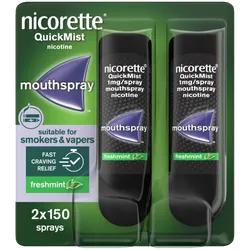How to use Niquitin
The strength of lozenge to be used will depend on the smoking habits of the individual.
NiQuitin Minis Mint 4 mg and 1.5 mg Lozenges are suitable for smokers who smoke more than 20 cigarettes a day.
One lozenge should be placed in the mouth and allowed to dissolve. Periodically, the lozenge should be moved from one side of the mouth to the other, and repeated, until the lozenge is completely dissolved (approximately 10 minutes). The lozenge should not be chewed or swallowed whole.
Users should not eat or drink while a lozenge is in the mouth.
Behavioural therapy advice and support will normally improve the success rate.
Adults (18 year and over)
Abrupt cessation of smoking:
Users should make every effort to stop smoking completely during treatment with NiQuitin Minis Mint 4 mg and 1.5 mg Lozenges.
Use the lozenges whenever there is an urge to smoke.
Sufficient lozenges should be used each day, usually 8-12, up to a maximum of 15.
Continue use for up to six weeks to break the habit of smoking, then gradually reduce lozenge use. When daily use is 1-2 lozenges, use should be stopped.
To help stay smoke free after treatment, users may take a lozenge in situations when they are strongly tempted to smoke.
Those who use lozenges beyond 9 months are recommended to seek additional help and advice from a healthcare professional.
Gradual cessation of smoking:
For smokers who are unwilling or unable to quit abruptly.
Use a lozenge whenever there is a strong urge to smoke in order to reduce the number of cigarettes smoked as far as possible and to refrain from smoking as long as possible.
The number of lozenges a day is variable and depends on the patients needs. Nonetheless it should not exceed 15 lozenges per day.
If a reduction in cigarette consumption has not been achieved after 6 weeks of treatment, a healthcare professional should be consulted.
Reduced tobacco consumption should lead to complete cessation of smoking. This should be attempted as soon as possible. When the number of cigarettes has been reduced to a level from which the user feels able to quit completely, then start on the schedule for "abrupt cessation" as given above.
If the attempt to stop smoking completely has not been started within 6 months after the beginning of treatment, it is recommended to consult a healthcare professional.
Temporary Abstinence
Use a lozenge every 1-2 hours to control troublesome withdrawal symptoms including craving. Users should not take more than 15 lozenges per day. Users should be encouraged to stop smoking completely as soon as possible. If users are still feeling the need to use the lozenges on a regular basis 6 months after the start of treatment and have still been unable to undertake a permanent quit attempt, then it is recommended to seek additional help and advice from a healthcare professional.
Children and adolescents:
Adolescents (12-17 years) should follow the schedule of treatment for abrupt cessation of smoking as given above, but restrict use to a maximum of 12 weeks duration. If longer treatment is required, or where adolescents are not ready or able to stop smoking abruptly, advice from a healthcare professional should be sought.
Safety and effectiveness in children who smoke have not been evaluated. NiQuitin Minis Mint 4 mg or 1.5 mg Lozenges are not recommended for use in children under the age of 12.
KEEP ALL MEDICINES OUT OF REACH AND SIGHT OF CHILDREN.
PLEASE READ ALL PRODUCT PACKAGING AND LABELS PRIOR TO USE.
Patient Information Leaflet












